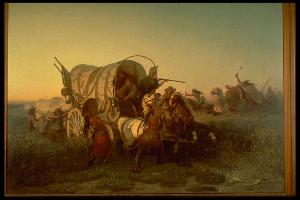Charles Ferdinand Wimar
Karl Ferdinand Wimar;Charles Ferdinand Wimar
Ort: Siegburg
geboren: 1828
Tod: 1862
Biographie:
Charles Ferdinand Wimar: Ein deutscher Maler in Amerika (1828-1862)** **Charles Ferdinand Wimar: A German Painter in America (1828-1862)
Charles Ferdinand Wimar, auch bekannt als Karl Ferdinand Wimar oder Carl Wimar, war ein deutscher Maler, geboren 1828 in Siegburg, Deutschland. Mit 15 Jahren wanderte er mit seiner Familie in die Vereinigten Staaten aus und ließ sich in St. Louis, Missouri, nieder. Wimar begann 1846 mit dem Studium der Malerei bei Leon Pomarede und reiste später den Mississippi River hinauf.Fruhes Leben und künstlerische Verfolgungen
Wimar's frühe Werke zeigen einen starken Einfluss der Düsseldorfer Schule, die er 1852 bei Emanuel Leutze studierte. Sein Werk The Abduction of Boone's Daughter by the Indians (1855-1856) ist ein Beispiel für seine künstlerische Fähigkeiten.
Späteres Leben und Beiträge zur amerikanischen Kunst
Wimar unternahm zwei lange Reisen den Missouri River hinauf (1858 und 1859) und malte Wandgemälde in der Rotunde des St. Louis Court House im Jahr 1861. Seine Beiträge zur amerikanischen Kunst sind bemerkenswert für die Darstellung der westlichen Indianer und der großen Büffelherden.
- Der Angriff auf einen Emigranten-Zug (University of Michigan Museum of Art, Öl auf Leinwand) zeigt Wimars Fähigkeit, dramatische Szenen zu malen.
- Wimars Werke sind auch im The Saint Louis Art Museum zu finden, einem kulturellen Schmuckstück in Amerika, das eine beeindruckende Sammlung von Kunstwerken aus verschiedenen Perioden und Regionen beherbergt.
Erbe und Erinnerungen
Charles Ferdinand Wimar starb 1862 in St. Louis, hinterlassend ein Erbe an Kunst, das weiterhin inspiriert und unterrichtet. Sein Leben ist ein Zeugnis für die dauerhafte Macht der Kunst, die Essenz einer vergangenen Ära zu fangen.
- Entdecken Sie mehr von Wimars Werken auf Wikioo.org
- Entdecken Sie die Kunstsammlungen Und Museen Augsburg, ein kulturelles Schatz in Augsburg, Deutschland, das eine beeindruckende Sammlung von Kunstwerken aus verschiedenen Perioden beherbergt.
Charles Ferdinand Wimar: A German Painter in America (1828-1862)
Early Life and Artistic Pursuits
Charles Ferdinand Wimar, also known as Karl Ferdinand Wimar or Carl Wimar, was a German-American painter born in Siegburg, Germany in 1828. He immigrated to the United States with his family at the age of 15 and settled in St. Louis, Missouri. Wimar began studying painting with Leon Pomarede in 1846 and later traveled up the Mississippi River.
Early Life and Artistic Pursuits
Wimar's early works show a strong influence of the Düsseldorf school, which he studied under Emanuel Leutze in 1852. His work The Abduction of Boone's Daughter by the Indians (1855-1856) is an example of his artistic skills.
Later Life and Contributions to American Art
Wimar made two long trips up the Missouri River (1858 and 1859) and painted murals in the Rotunda of the St. Louis Court House in 1861. His contributions to American art are notable for capturing the essence of Western Native Americans and the great herds of buffalo.
- The Attack on an Emigrant Train (University of Michigan Museum of Art, Oil on Canvas) showcases Wimar's skill in capturing dramatic scenes.
- Wimar's work is also featured in the The Saint Louis Art Museum, a cultural gem in America, which houses an impressive collection of artworks from various periods and regions.
Legacy and Remembrance
Charles Ferdinand Wimar passed away in 1862 in St. Louis, leaving behind a legacy of art that continues to inspire and educate. His life's work is a testament to the enduring power of art in capturing the essence of a bygone era.
- Explore more of Wimar's works on Wikioo.org
- Discover the Kunstsammlungen Und Museen Augsburg, a cultural treasure in Augsburg, Germany, featuring an impressive collection of artworks from various periods.


